
I am currently under contract with a Major League Rugby (MLR) team here in the United States. MLR is the new kid on the block with regard to professional leagues in the USA but has shown that it has staying power, with three new teams being added to the schedule in 2020, taking the number of competing teams to 12 across two conferences.
Having worked in the Japanese professional rugby league as well, I have seen a reliance on the import of overseas players here in the US. My team has 12 nationalities represented in the playing roster. These players make up approximately 40% of the players on the overall squad.
RECENT: Flow Chart to Assist in the Determination of Physical Training Content in a Week-Long Plan
We often sit around the coaching table and discuss ways in which to increase the team’s US content. This is being addressed with major initiatives at the grassroots level by introducing flag rugby into elementary schools and also by teaching rugby tackling to football programs. It was interesting for me to attend a recent USA Rugby seminar. The “ice breaker” to start proceedings was as follows: the speaker asked all of the delegates to stand; there were approximately 50 people in the room. His first command was to “Sit down if you were introduced to rugby post college.” Quite a few people sat. Then, his next command was to “Sit down if you were introduced to rugby post high school.” An even larger number of people in the group sat down. Next, he said, “Sit down if you were introduced to rugby during the past two years of high school.” There were approximately four people still standing. This certainly begs the question of whether the game needs to reach out to younger participants. I started playing when I was eight years old after playing a year in soccer.
The other perspective is, where do all of the football players go when they are unable to reach their playing goals in college or the National Football League? I read the following information on the National Collegiate Athletic Association website while preparing this article, and it amazed me and initiated discussions in our coaching group.

I am guessing that some players find their way into the Canadian Football League or other competitions around the world, but most start seeking out alternative employment in the non-sporting world. I believe that rugby offers a unique opportunity to keep your sporting hopes and dreams alive. It allows you to not only earn a respectable income for you and your family but also it potentially allows you to represent your country in international rugby fixtures.
The transition will be difficult. Your physical skill set has been geared over a number of years to short-term, explosive efforts with little aerobic training. Rugby, on the other hand, will still require those short-term explosive efforts, but you will have to do them repeatedly over the game. So, a well-developed aerobic engine is required. You can test yourself on a number of aerobic tests. A selection of these tests is included below:
- Multistage Fitness (Beep) Test
- 30-15 Intermittent Fitness Test (IFT)
- Yo-Yo Intermittent Recovery Test Level 1 or 2
- 1200m Shuttle (Bronco)Test
- Cooper 1.5 mile / 2.4 km Run Test
I have used all but the 30:15 IFT over the years as a rugby fitness coach, and my preference for the aerobic test when players come back into training from a break is the 2.4km run, as it does not require any change in direction. Of course, you ideally need access to a track or an accurately measured equivalent around a rugby field. Most recently, I have moved almost exclusively to the Bronco test due to the ease with which you can test players on the rugby field with this test. I use the lines on the field to make it even easier using the 22m line (instead of a 20m line), and then, I use the 10m line at (40m and 60m) to complete the test course.
To give you an idea of how your results would compare with those of a professional rugby player by position, I have included a table below:
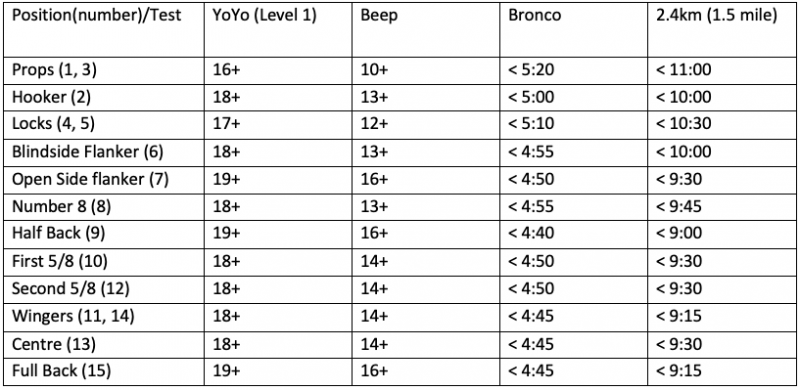
What position should you be looking at if you are a football player wanting to play rugby?
In a wonderful article entitled “The Perfect Rugby Animal” by John Mitchell, he includes a table based on the heights and weights of players per position. Rugby is a game for all sizes, and I have seen international players who do not measure up to these standards, so it should be used as a guide only.
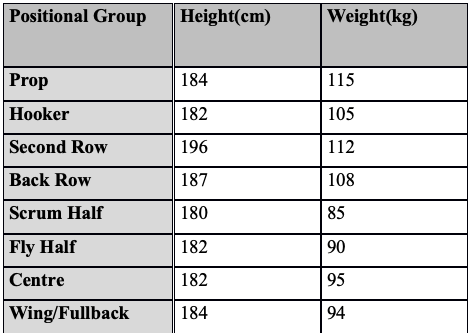
I believe that the following positions in football would have the best chance of transferring to rugby given the time needed to learn new ruby skills and adapt to the game’s physical demands:
Running Backs, Wide Receivers, Tight Ends, Center, Quarter Back, Left Tackle, Linebacker, Safety, Corner, Defensive End
Here are some charts from the NSCA that provide a clear picture of the physical sizes of college football players.
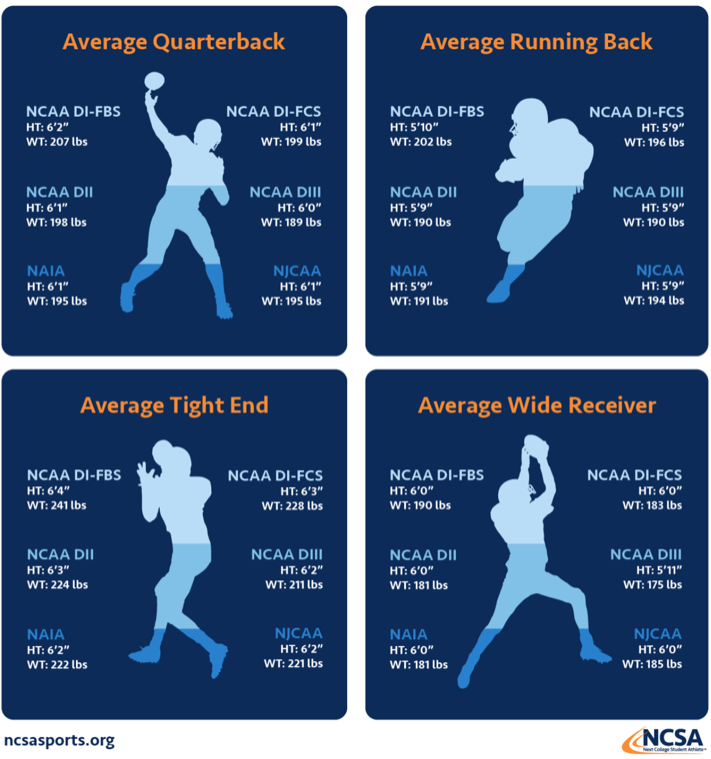
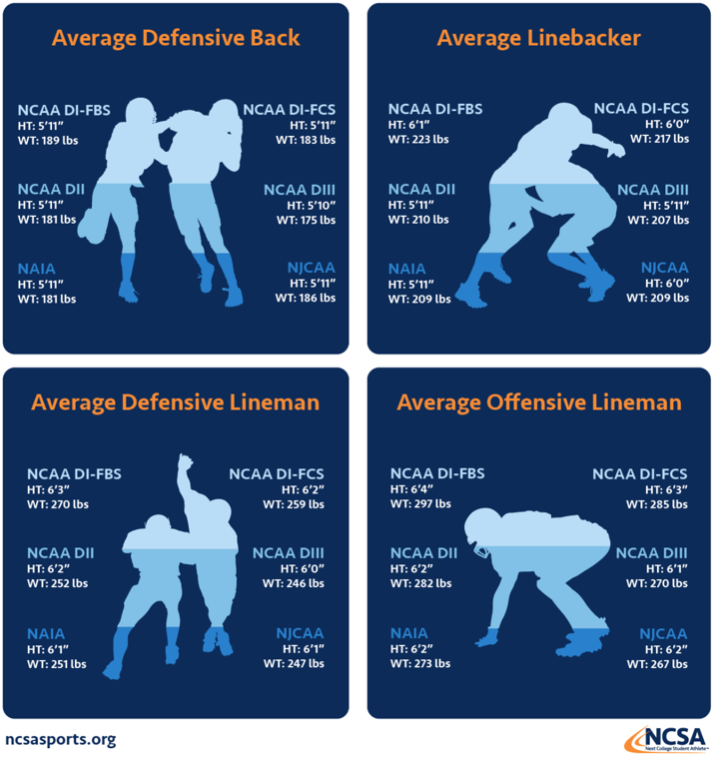
Although MLR currently is not playing, teams will be looking at talent from across a wide range of collegiate sports, not just football. Combines for “cross-over” athletes from sports as diverse as rowing, basketball, lacrosse, and wrestling will certainly be looked at in future recruiting as the league expands.
Feel free to contact me directly here at elitefts if you think you have what it takes to transfer to rugby.
Header image credit: ARAK7 © 123rf.com










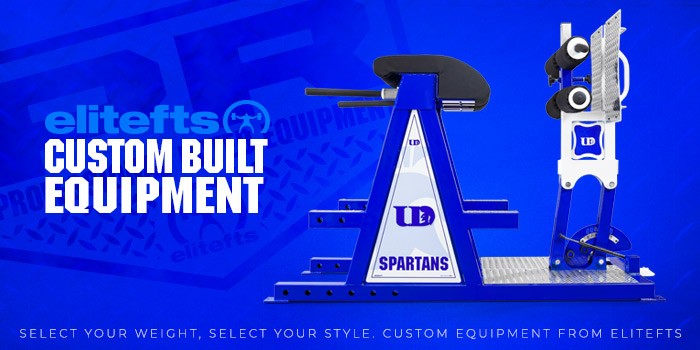
Thanks for the reply! I will definitely take you up on that offer once things settle down! Thank you so much
Michael Hegedusich
Really appreciate everything you do for the industry.
I am originally from the US where I did my undergrad (CSCS, ATC) and am currently in Australia doing a post grad degree (DPT). I have been working with a Rugby team over here as the S&C coach and have really been enjoying it. The coach of the team Jed Hogan, said he connected with you at a seminar with Glen Corcoran. He suggested to try and contact you to possibly have a chat to learn more about training Rugby. I listened the elitefts podcast you were on and know you suggested this is the best way to contact you.
If you do have some time, the included email address with the comment would be an easy place to contact me.
Appreciate your time.
Respectfully,
Patrick Wood
I’ve recently discovered your work and appreciate the manner in which you explain your programs. I’ve tried a couple and found them to be quite beneficial to me. So thank you for sharing them. I would have loved finding your work sooner.
Being a fan of rugby from Super Rugby to the Gallagher Premiership and having played a little in college, any insight on how I could go about working for a team? My background is exercise science and I’ve been operating medium to large fitness facilities for over 19-years. I love the game and want to work within it. Thank you for your time and any insight is greatly appreciated.
Scott